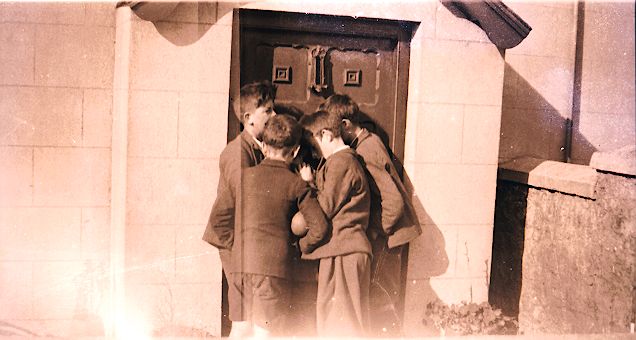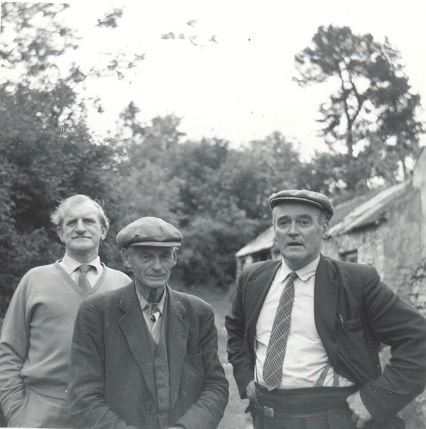Michael J Murphy – A short biography
Michael Joseph Murphy was born in Eden Street, Liverpool, in June 1913. His parents were Michael ‘Buck’ Murphy and Mary Campbell, both natives of the Dromintee area of South Armagh. In 1922, when he was eight and a half years old, the family returned to Dromintee.
He attended Dromintee National School and when he was just fourteen years old he left school and went to work as a farm worker with local farmers. He developed an interest in storytelling, the imaginative language and the folk beliefs of the people around Slieve Gullion. He began to write down stories and sayings; take photographs and to publish in local and provincial newspapers. He read widely and by 1938 had begun a career in broadcasting.
After the publication of his first book ‘At Slieve Gullion’s Foot’, in December 1941, he joined The Folklore Commission and went on to record what is probably the largest collection of oral tradition ever collected in the English-speaking world.
He campaigned, as a socialist republican, against the social, political and environmental problems in Ireland; published ten books; wrote six plays and scores of short stories.
He retired from The Department of Irish Folklore, University College Dublin, in 1983 and died in 1996 in Walterstown, Castlebellingham, Co. Louth. He is buried, along with his wife, Alice, in Darver cemetery.
Michael J. Murphy A short biography
DownloadMichael J Murphy – Letter Writer and Photographer
Michael J. Murphy, from his teenage years, was a prolific letter-writer and photographer.
When he was nineteen years old he published an article on the harvest and Maud Gonne MacBride wrote to the young farm worker to praise the piece and to encourage him to continue writing.
He corresponded throughout his life in thousands of letters with poets; playwrights; publishers; political figures; social campaigners; ordinary country people; folk storytellers; international critics; theatre, radio and television producers and a host of others at home and abroad.
Some of the figures with whom he was in contact were John Hewitt, Sam Hanna Bell, John Boyd, L.A.G. Strong, Elizabeth Bowen, Maud Gonne MacBride, Peadar O’Donnell, Sean O’Faolain, Paul Vincent Carroll – to name but a few.
Michael began to photograph people and places around Dromintee when he was still a teenager. In the early days he developed his own negatives in an improvised dark room in his parents’ house. He went on to photograph throughout ‘Old Ulster’ (from Rathlin to the Boyne).
If his letters and photographs are ever collected together they will be a unique record of the twentieth century.
Michael J Murphy – Social and Political Campaigner
Michael J. Murphy inherited from his father and mother a highly-developed social conscience.
McGuill’s Public House, Dromintee, which was burned by British Forces in 1922, pictured in the 1950s. It is now called ‘The Three Steps’.
Both of his parents had been hired at the hiring fair in Newry when they were ten years old and the stories which he heard from them had a profound effect on him.
His mother was paid thirty shillings(£1-50)for her first six months when she was ten and in later life she said that she had a weak chest and erysipelas from continual wettings while hired with inconsiderate farmers.Her son campaigned throughout the 1930s against this ‘slave market’ which caused so much hardship for the children of the rural poor.
His father,who was a seaman and worked and travelled widely,had a big influence on him as a socialist republican.Michael senior was a personal friend of both James Connolly and Jim Larkin. One of Michael junior’s abiding passions was that he saw republicanism as being continually compromised by greed and he returned to this theme over and over again in his articles,short stories,plays and broadcasts.
His contacts with such people as Kathleen Clarke,Maud Gonne MacBride and Peadar O’Donnell were important influences on this aspect of his life.

Michael J Murphy – The Creative Writer
Michael J. Murphy was not without a literary background within his own family. His paternal great-grandfather, William Jordan of Tiffcrum, Forkill, South Armagh, was a Gaelic scribe and a minor Gaelic poet.
William Jordan’s son, Pat Jordan,passed on medieval tales to his nephew, Michael Murphy senior,and consequently to Michael J. himself. His maternal grandfather, John Campbell, was a storyteller and also influenced the emerging writer.
His national school teacher, Paddy Hearty, was important also as he encouraged creative writing in his pupils and through the Catholic Students’ Library, Dublin, Michael borrowed books and read a wide range of contemporary and classical literature.
However, he was mainly inspired in his creative work by the richness of imagery and vividness of language of the country people. Therefore he is the last, and possibly the only, authentic voice of South Armagh language in written form.
The landscape and the earth around the mystic mountain, Slieve Gullion, was a constant inspiration. He returns to the mountain continually in his work and describes all of its moods and mystery.
The encouragement of Maud Gonne, L.A.G. Strong and others helped to develop his creative talent and his continual perusal of Alexander Blair’s ‘Belles Lettres’ honed his literary style.
His prose poems, short stories, plays, journals and novels give us a writer who deals realistically with the complexities of rural life and the struggle with materialism and the environment.

The Weakness – Short Story
DownloadMichael J Murphy – The Folklore Collector
Michael J. Murphy was, even before he came to Dromintee in 1922, aware of the rich store of folk material through his parents and their South Armagh emigrant friends.
As a young schoolboy and later as a farm worker he was fascinated by the talk, customs and beliefs of the people.He began to write down these pieces and to submit them to newspapers such as ‘The Irish Weekly’,’The Irish Press’,The Evening Herald’,’The Irish News’,’The Belfast Telegraph’ and ‘The Cork Examiner’.
It was these published articles, which were collected in book form in ‘At Slieve Gullion’s Foot’(1941), that led to his employment as a collector for The Irish Folklore Commission,Dublin.
He branched out from his native South Armagh in the next forty-one years to collect folklore all over ‘Old Ulster’—-notably in the Sperrin Mountains of Co. Tyrone;North Antrim;Rathlin Island;The Mourne Mountains;The Cooley Peninsula and North Louth;Sligo;Fermanagh and Cavan.
His collection,now housed in The Department of Irish Folklore,University College,Dublin,consists of over 150 volumes which is probably the largest collection of oral tradition by a single individual in the English-speaking world.
In addition to the collection,he also compiled a glossary of Anglo-Irish speech and kept a detailed journal of his travels.
Two brief folktales from ‘Now You’re Talking’ 1975:
Pigs Can Go Under a Big Pot
This fellow went to Newry one day and bought two suckers [small pigs] and he was carrying them home. He fell in with a girl he knew and she’d bought a pot and was carrying it home. He had the suckers and she had the pot: and she said till him that she was afeared of him. He asked for why she was afeared of him.
‘Amn’t I carrying two suckers?’ says he. ‘What could I do? I can’t leave them down the suckers …’ [To court her].
‘You can put them under the pot,’ says she. [Suggestively: that he do so].
The Flea’s Wake
In England for the first time Paddy was looking for lodgings.
He had heard fearsome stories about the fleas in English rooms; so he asked his landlady if there were any in the room he had taken. He asked her to be honest about it. She confessed that there might be one.
At breakfast next morning he said he had good news for her. ‘That flea of yours is dead,’ says Paddy; ‘ for all the fleas in the street were up there at his wake last night.’
Who were the fairies – Michael J Murphy
DownloadMichael J Murphy – The Broadcaster
Michael J. Murphy was a natural broadcaster in that his mellow voice and relaxed delivery led to easy listening.
His career in broadcasting began in 1938.His first broadcast was ‘The Goatmen of South Armagh’ which was produced by Henry McMullan for the B.B.C. in Belfast.
Talks for both the B.B.C. and Radio Eireann followed and in the 1940s Radio Eireann broadcast half-hour features once per month.This brought his voice to a wider audience and he began to broadcast for Radio Newfoundland and for the B.B.C Pacific Service.His work for B.B.C. Belfast consisted of scripted talks for programmes like ‘Country Window’, ‘Ulster Magazine’, ‘Writing in Ulster’ and ‘Country Magazine’.
He made a large number of children’s programmes in series such as ‘Children’s Hour’ and ‘Today and Yesterday in Northern Ireland’.
These scripted talks led to his writing of a number of radio plays and the development of lifelong friendships with writers and producers like Sam Hanna Bell,John Boyd,W.R. Rodgers,David Hammond and Cecily Matthews.
He made a number of television programmes for the B.B.C. and UTV,most notably ‘Ulster in Focus’ and ‘Ye Barbarous Mountaines’.
In 1982 The Arts Council of N. Ireland issued a recording of his readings featuring his prose poems,autobiographical articles and folk tales.
Download Michael J. Murphy’s first broadcast for the BBC “The Goatmen of South Armagh” below.
The Goatmen of South Armagh – Michael J Murphy
DownloadMichael J Murphy Winter School
The Michael J Murphy Winter School is the idea of commemorating the work of Michael J. Murphy in his native south Armagh began in may 1992 when An Cumann le Bealoideas Eireann (the Folklore of Ireland Society) decided to hold its annual ‘Tionol’ in Aras an Phobail, an Mullach Ban.
In may 1999 a local committee, based in the newly opened Ti Chulainn Cultural Activity Center, organised a Michael J Murphy Winter School under the title ‘The Rural Landscape in the New Millenium’ and followed up in May 2000 with the theme ‘The Literature of the Land’ in Dromintee GAA social club and Ti Chulainn.
After a lapse of a number of years the Cuimhneamh Oral History group based in the rejuvenated Ti Chulainn Centre marked the centenary of Michael J’s birth in 1913 by re-issuing his first book ‘At Slieve Gullion’s Foot’ at a Michael J Murphy Winter School, which featured an exhibition of his outstanding photographs. It continued with a similar event in November 2014 and in November 2015 when the theme was ‘A Sense of Place’ and also saw the introduction of ‘The Michael J. Murphy short story competition’.
The Michael J. Murphy winter school has now become an essential highlight in the cultural calendar.

































